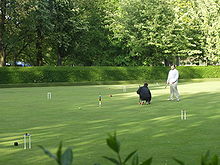This article possibly contains original research. (July 2016) |




A lawn (/lɔːn/) is an area of soil-covered land planted with grasses and other durable plants such as clover which are maintained at a short height with a lawn mower (or sometimes grazing animals) and used for aesthetic and recreational purposes—it is also commonly referred to as part of a garden. Lawns are usually composed only of grass species, subject to weed and pest control, maintained in a green color (e.g., by watering), and are regularly mowed to ensure an acceptable length.[1] Lawns are used around houses, apartments, commercial buildings and offices. Many city parks also have large lawn areas. In recreational contexts, the specialised names turf, parade, pitch, field or green may be used, depending on the sport and the continent.
The term "lawn", referring to a managed grass space, dates to at least the 16th century. With suburban expansion, the lawn has become culturally ingrained in some areas of the world as part of the desired household aesthetic.[2] However, awareness of the negative environmental impact of this ideal is growing.[3] In some jurisdictions where there are water shortages, local government authorities are encouraging alternatives to lawns to reduce water use. Researchers in the United States have noted that suburban lawns are "biological deserts" that are contributing to a "continental-scale ecological homogenization."[4] Lawn maintenance practices also cause biodiversity loss in surrounding areas.[5][6] Some forms of lawn, such as tapestry lawns, are designed partly for biodiversity and pollinator support.
- ^ Encyclopedia of Urban Studies. SAGE. 2010. pp. 441–45. ISBN 9781412914321.
- ^ Robbins, Paul. Lawn People: How Grasses, Weeds, and Chemicals Make Us Who We Are. Philadelphia: Temple University Press, 2007. ISBN 1592135781
- ^ Shern, Lois C.; Sloan, Ann C. (1996). "The Impact of the American Lawn Ideal on Environmental Liveability". Human Ecology Review. 3 (1): 102–107.
- ^ "Are our lawns biological deserts?". beta.nsf.gov. National Science Foundation. 11 July 2018. Retrieved 14 July 2022.
- ^ Proske, Anja; Lokatis, Sophie; Rolff, Jens (2022). "Impact of mowing frequency on arthropod abundance and diversity in urban habitats: A meta-analysis". Urban Forestry & Urban Greening. 76: 127714. Bibcode:2022UFUG...7627714P. doi:10.1016/j.ufug.2022.127714. ISSN 1618-8667.
- ^ Hostetler, Mark E.; Main, Martin B. "Native Landscaping vs. Exotic Landscaping: What Should We Recommend?". wec.ifas.ufl.edu. University of Florida. Retrieved 14 July 2022.